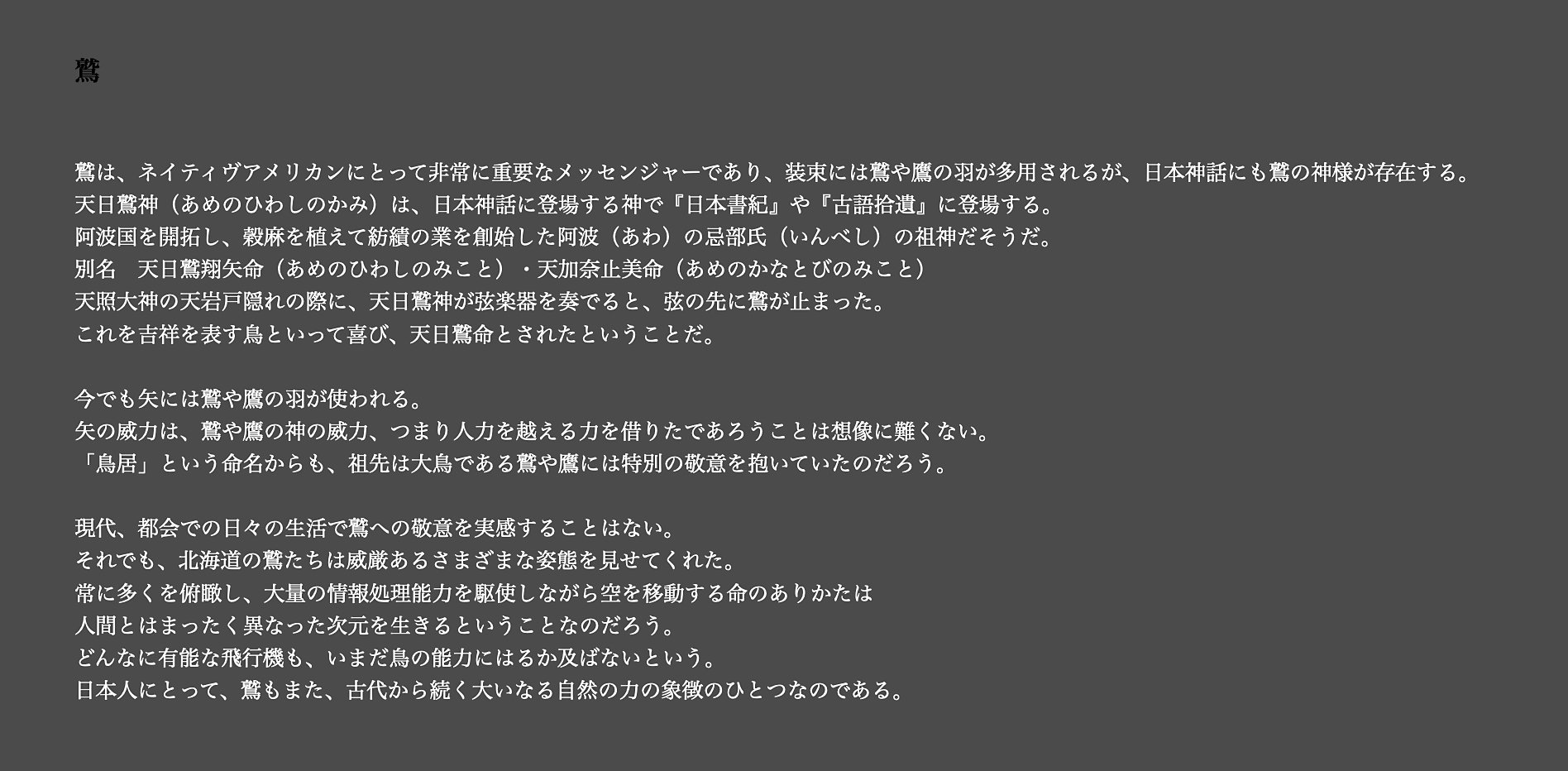Birds of Japanese Myths and Folklore
This series was inspired by an experience I had while photographing torii gates built in water, which are a symbol of Japanese nature worship. The word torii is written using the character for “bird,” and fittingly, as I stood there, a large flock of birds landed on the torii to rest. What must our ancestors have thought when they saw birds perched on the gates built to welcome the gods of nature? These photographs express the impressions I felt as I came face to face with the birds depicted in folklore and mythology—cranes, eagles, and chickens. My hope that, rather than viewing the images of these birds as wildlife photography, you will experience them as fine art.

"Tancho - Japanese red crown crane"

The Crane’s Gratitude
In this Japanese folk tale, an old man rescues a crane who has been caught in a trap. To express her gratitude, the crane transforms herself into a young maiden and comes to live with the man and his wife as their child. Every night she retreats to a weaving shed where, once again a crane, she plucks her own feathers and weaves them into beautiful cloth that she gives to the elderly couple. She tells them that they must never look into the shed when she is weaving, but one night the old woman does look, and finds that the girl is a crane. Once she has been seen, the crane can no longer live with the elderly couple, and flies away into the sky.
Kushiro, Hokkaido. The vision of Japanese cranes stretching their wings in a field of snow, the red on the crowns of their heads reinforcing the thought of them as a manifestation of Japan, is breathtakingly beautiful. In the bitter -20°C cold of early morning, they stand silent and still on the river, filling the depths of my heart with the beautiful, fleeting strength of life.
How much of this wildness do we humans have left?
Shutting myself up alone in my workroom to finish a project, I think about this question, and feel as if I have turned into the crane-maiden weaving her cloth.

"Eagle"
The feathers of eagles and hawks are widely used in the costumes of Native Americans. Japanese mythology, too, has an eagle god, appearing in the Nihon Shoki and Kogo Shui (A historical record of the Inbe clan of Shinto practitioners, composed in 807 A.D. as Amenohiwashi-no-kami. Also called Amenohiwashi-no-mikoto and Amenokanatobi-no-mikoto, he is granted his name when he plays a stringed instrument after Amaterasu hides herself in the cave of heaven, and an eagle perches on the end of his strings. The bird is joyfully declared an auspicious omen, and he is becomes known as “Amenohiwashi-no-kami”, washi being the Japanese character for “eagle”. Our ancestors likely felt a special respect for large birds like eagles and hawks. Within today’s urban culture, there is little opportunity to directly experience this feeling of respect for wild eagles. The fletching on the arrows used in Shinto ceremony and Japanese archery offer a small glimpse, but the Hokkaido eagle in these images treated me to a show of many dignified poses. Constantly looking down on a vast swath of earth as they move across the sky, freely using their powerful ability to processing all that information, eagles exist in an entirely different dimension than humans. Even the most advanced airplanes and jets do not remotely approach the capacity of a bird. For Japan, the eagle is a symbol of the great power of nature that has existed since ancient times.

"Mythical Chicken"
These shinkei, or “mythical chickens,” live on the light-filled grounds of one of Japan’s most ancient shrines. But why do we call them “mythical”? The answer can be found in a story recorded in the Kojiki. According to this ancient text, the sun goddess Amaterasu became angry at her brother Susanoo, the god of storms and seas, for his violent ways, and shut herself into a cave, plunging the world into darkness. The other deities gathered at Amanoyasu Kawara and asked Omoikane, the god of wisdom, to come up with a plan to lure Amaterasu back out. At his direction, they gathered Tokoyo-no-naganakidori, long-crowing roosters from the eternal world who bring the morning, and made them crow. Ame-no-uzume, the goddess of dawn, danced in front of the cave, and using a bronze mirror, she succeeded in drawing out Amaterasu. Thereafter, Tokoyo-no-naganakidori were viewed as divine messengers.
Shimmering in the sunlight like the wings of a jewel beetle, the brilliantly colored feathers of these Totenko chickens can only be described as the handiwork of the gods. Bodies elegant, cockscombs blazing like the rising sun, tails trailing like ribbons: their beauty is such that I feel a deep, instinctual desire to adorn myself in all of it as well. Another breed, the Minohikidori, struts nobly and elegantly about, its feathers a stylish black-and-white. Spending a bright winter day with these creatures, I felt the aesthetic appreciation that my ancestors had for these birds awakening within me as well. Inspired by the Edo-era artist Ito Jakuchu, I composed these images in the style of traditional hanafuda flower cards, integrating images of trees that symbolize nature in Japan.

-Eriko Kaniwa
Copyright (c) 2008-2022 by SENSEGRAPHIA- Eriko Kaniwa. All rights reserved.
All Images on this site are fully copyrighted, may not be used without written permission.


